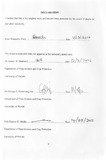| dc.description.abstract | Maize is the staple food for the majority of households in East and Central Africa and the per capita consumption in Kenya is about 97 kg per year per person. However, the recurrent outbreaks of aflatoxin poisoning in Kenya as exemplified by outbreaks in 1981,2004,2006, 2007,2009 and 2010 poses a major food safety concern. This study was therefore conducted to evaluate susceptibility of maize varieties to one of the main mycotoxin producing fungi, Aspergillus flavus and effectiveness of grain-inhabiting antagonistic micro-organism in the management of Aspergillus flavus.
Field trials were conducted over two growing cropping seasons in 2008 and 2009 at Mwea and Waruhiu. Cobs of 16 maize varieties: Duma 43, Dekalb 8031, Dry Highland 01, Dry Highland 02, Dry Highland 04, Panner 77, Panner 7-19M, Panner 4M, Panner 67/5243. Hybrid 513, Hybrid 515, Hybrid 516. Katumani, Hybrid 614, Pioneer 3253 and Katumani composite B were inoculated with A. flavus through the silk channel.
Parameters assessed in the field included, number of days to 50% silking, days to maturity, cob husk coverage and Aspergillus rot on cobs. Clean grain samples (500g) were adjusted to 10, 13.5, 15, 17, 20% and A, flavus re-isolated after 7,28 and 84 by plating on Czapek Dox Agar and aflatoxin BJ content by enzyme linked immunosorbent assay (ELISA). Growth inhibition of A. flavus by grain inhabiting antagonistic fungi in culture was evaluated by paired culture of A. flavus with Fusarium oxysporum, Trichoderma sp, Alternaria sp, A. niger, and A. terreus.
Fungi showing growth inhibition of A. flavus were co-inoculated with A. flavus on to maize grain adjusted to 17% moisture content and incubated for 28 days. Aspergillus flavus was reisolated by plating on Czapek Dox Agar and aflatoxin BJ content determined by ELISA method. Varieties differed significantly in days to 50% silking and maturity. Variety Katumani composite B silked and matured earliest at 60 and 87 days respectively, while H614 silked and matured at 87 and 137 days respectively.
The varieties differed in Aspergillus rot rating, with Katumani having the highest rating of 17%, while Hybrid 614 and Duma 43 had the lowest Aspergillus infection of 2.5%. Kernels infection with Aspergillus flavus was significantly different among the varieties, with Panner 77m having a higher infection of 3L 1% and Katumani ユ .B, which had infection of 16.40/0. Higher moisture levels above 15% and longer grain incubation periods (7days to 28 days) resulted in increased
Aspergillus flavus kernel infection.
Varieties significantly (P~0.05) differed in aflatoxin B, content with H516 having the highest aflatoxin content of 462 ug/kg compared to Katumani composite B which had the least aflatoxin content of 14 ug/kg, Fungal antagonists significantly differed in reducing A. flaws colony diameter with Trichoderma and Alternaria showing the highest (30.7%) and the least (12%), reduction respectively. The highest reduction of A. flavus was observed in different maize varieties co-inoculated with Trichoderma while the lowest reduction of A. flavus was observed in different maize varieties inoculated with A. flavus alone.
The results indicated that all the maize varieties were susceptible to A. flavus ear rot and aflatoxin contamination, although a few showed some tolerance. Grain inhabiting fungi showed promise in reducing growth of A. flavus and aflatoxin accumulation in grain. Further research on biological management of A. flavus and aflatoxin contamination is required. In addition, farmers in aflatoxin poisoning-prone areas should be encouraged to grow maize varieties that are less susceptible' to A. flavusand associated aflatoxin contamination. | en_US |

